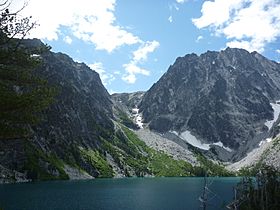Aasgard Pass facts for kids
Quick facts for kids Aasgard Pass |
|
|---|---|

Aasgard Pass, viewed from the northwest across Colchuck Lake
|
|
| Elevation | 7,841 ft (2,390 m) |
| Traversed by | Unmaintained United States Forest Service foot trail |
| Location | Chelan County, Washington, US |
| Range | Stuart Range, in the Cascades |
| Coordinates | 47°28′49″N 120°49′14″W / 47.48028°N 120.82056°W |
Aasgard Pass is a famous mountain pass in the Cascade Mountains of Washington. It is officially known as Colchuck Pass. This pass is about 7,841 feet (2,390 m) high. It is located in the Alpine Lakes Wilderness, near Leavenworth.
Aasgard Pass is a popular route for hikers. It leads into a beautiful area called the Enchantments. This area is one of Washington's most loved hiking spots. The pass is known for being a shorter but very steep way to get there.
The pass connects two important areas. To the northwest, it meets Colchuck Lake, which is about 5,570 feet (1,700 m) high. To the southeast, it leads to the Upper Enchantment Basin, around 7,500 feet (2,300 m) high. Aasgard Pass sits between Dragontail Peak and the Enchantment Peaks.
What's in a Name?
You might wonder why it has two names. Officially, it is called Colchuck Pass. But many hikers and climbers know it as Aasgard Pass.
Why Two Names?
The name "Colchuck Pass" is the official one. You will see it on maps from the United States Geological Survey (USGS). This is because the United States Board on Geographic Names decided to keep this name. They turned down requests to change it in 1967 and 1988.
How "Aasgard Pass" Became Popular
Even though it's not official, the name "Aasgard Pass" is very popular. A famous climber and writer named Fred Beckey preferred this name. It was likely first used by Bill and Peggy Stark. They explored the Enchantments a lot in the middle of the 20th century.
The Starks gave many places in the Enchantments names from Norse mythology. This included names like Aasgard. Before them, A. H. Sylvester had named many of these lakes. He was a supervisor for the U.S. Geological Survey in the early 1900s.
Official Naming Rules
In the 1960s, the US Board on Geographic Names made rules for naming places. This led to a mix of the old and new names becoming official. Today, it is hard to get new names approved for places in wilderness areas. This means many of the names the Starks used might never become official.

